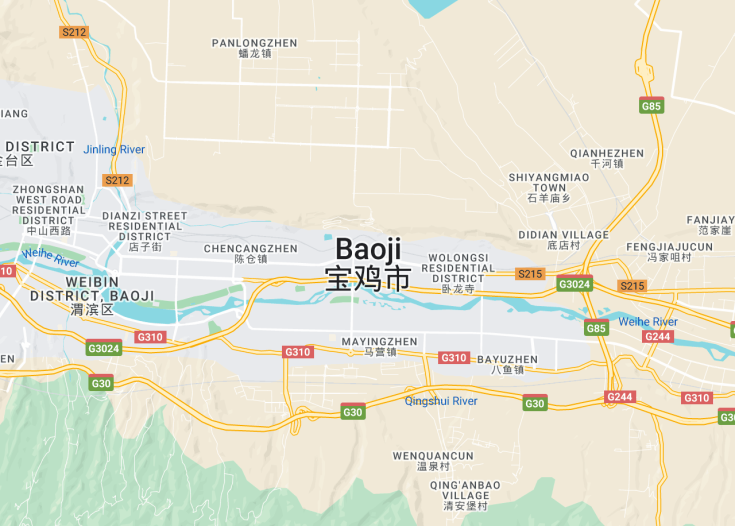Baoji, located in Shaanxi Province of China, is a city rich with historical and cultural significance, best known as the hometown of Emperor Yan. The region offers an abundance of historical sites including the Famen Temple, famous for housing the finger relic of Siddhārtha Gautama. The city serves as a gateway to explore the majestic Qinling Mountains, offering breathtaking natural landscapes. Baoji’s prestigious past, coupled with its artifacts displayed in the Baoji Bronzeware Museum, encapsulates a significant portion of China’s ancient civilization and allure.
Visit Baoji during the spring or autumn seasons to enjoy pleasant weather while exploring its rich tapestry of historical landmarks and natural scenery.
Consider visiting the Baoji Bronzeware Museum early in your trip; it provides context that will enrich your understanding of the area’s extensive historical heritage.
Top things to do & see in Baoji
Select the following sights and activities to discover best tickets and tours available in Baoji.
Baoji: Gateway to Ancient Chinese Splendors
| Country | China |
| Time in Baoji | GMT+8 |
| Language spoken | Mandarin |
| Population | 3,716,731 (China Statistical Yearbook 2022) |
| Currency | Chinese Yuan (¥ / CNY) |
| Airports |
|
Baoji, located in the Shaanxi province of China, is one of the cradles of Chinese civilization with a history that dates back over 5,000 years. Known as the hometown of Yan Di, one of the legendary “Five Emperors”, Baoji is rich in cultural and historical significance. This ancient city is blessed with numerous relics and sites, including the Jintai Taoist Temple and the renowned Famen Temple is known for housing the finger bone relic of the Sakyamuni Buddha.
The city’s history is highlighted by its role in early Chinese bronze ware making, showcased at the Baoji Bronze Ware Museum, which holds an extensive collection of ancient bronzes, weapons, and tools. Baoji is also a gateway to the majestic Taibai Mountain, one of the highest peaks in the Qinling Range, which has been an inspiration for many classical Chinese poems and paintings.
Modern Baoji is a vibrant hub of industry and technology, benefiting from its strategic location on the Silk Road Economic Belt. Its urban development and transportation network make it an accessible destination for both tourists and business travelers, reflecting a unique blend of ancient heritage and modernity. The city’s commitment to preserving its history while fostering economic growth and innovation provides a dynamic environment for exploring China’s rich past and bright future.
Where is Baoji?
Baoji is situated in Western China, within Shaanxi Province, nestled between the Qinling and Taibai mountains.
Distances:
| Route | Distance by car | Time by car |
|---|---|---|
| Xi’an to Baoji | 187 km | Approx. 2 hours 15 minutes |
| Chengdu to Baoji | 625 km | Approx. 7 hours |
What is Baoji famous for?
Baoji is renowned for being a significant historical city on the Silk Road, famed for its ancient bronzes, beautiful landscapes, and as the birthplace of Yan Di, one of China’s legendary emperors.
History
Ancient Beginnings (Before 2000 BC)
The region around Baoji has been inhabited by early humans for thousands of years, with archaeological evidence suggesting the presence of prehistoric cultures such as the Longshan. The fertile plains and abundant resources made it an ideal location for ancient human settlement.
Establishment of the City (1045 BC – 221 BC)
Baoji is believed to have officially been established during the Zhou Dynasty when it served as an important military and cultural center. The city played a crucial role in the development of the Zhou dynasty’s feudal system and served as a strategic location for various military campaigns.
Imperial Influence (221 BC – 1911 AD)
Throughout various dynasties, including the Qin, Han, and Tang, Baoji continued to be a pivotal regional center. During the Tang dynasty, it became known for its scholarly achievements and was a hub for the spread of Buddhism in China.
Modern Era (1912 – Present)
In the 20th century, Baoji developed as a significant industrial city within Shaanxi Province. It has also embraced tourism, focusing on its rich historical heritage and natural beauty to attract visitors from around the globe.
Visit Baoji
What to see and do in Baoji, China.
Baoji, located in Shaanxi Province, is rich in cultural heritage and natural scenery. Key attractions include:
- The Baoji Bronze Ware Museum, showcasing an extensive collection of ancient bronzes.
- Famen Temple, known for housing a relic of the Buddha’s finger bone.
- Mount Taibai, the highest peak in the Qinling Range, offering stunning views and challenging treks.
- The Wei River, a perfect spot for scenic walks and picnics by the water.
Cultural Festivities in Baoji
Baoji is vibrant with cultural events, especially the Baoji Folk Culture Festival, typically held in autumn. This event showcases local arts, crafts, and traditional performances, providing a deep dive into the cultural fabric of the region.
Best time to visit Baoji
The optimal time to visit Baoji is during the spring (April to June) and autumn (September to October) months when the weather is mild and the natural landscapes are particularly striking.
Is Baoji worth visiting?
Baoji offers a rich tapestry of history and culture, making it appealing for those interested in China’s ancient civilizations. The natural landscapes are remarkably beautiful, providing both relaxation and adventure opportunities. However, visitors may find the transportation within the area less convenient compared to more developed tourist cities. Despite this, Baoji’s cultural depth and scenic beauty make it a worthwhile destination for those looking to explore beyond China’s more frequented locales.










